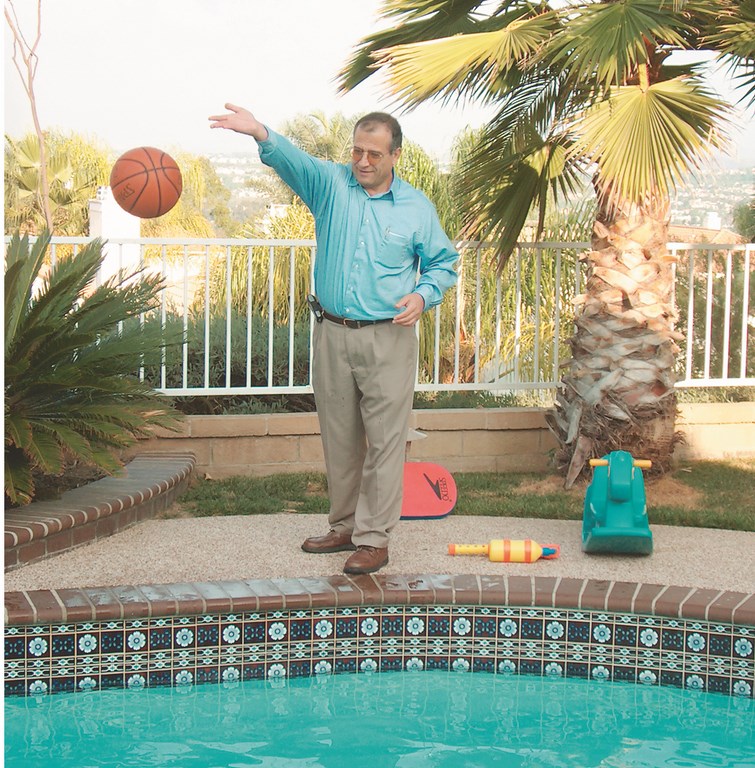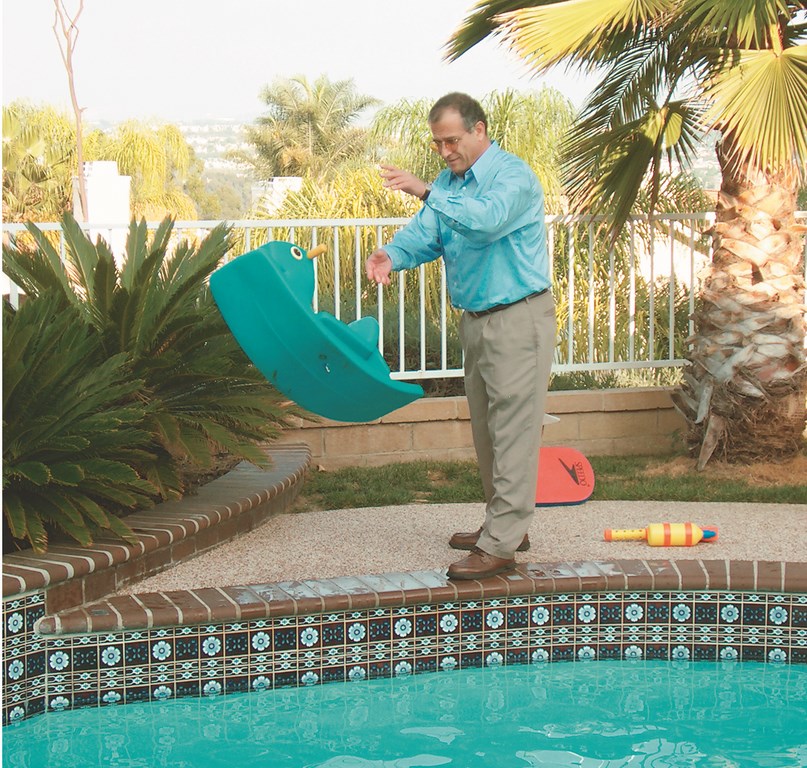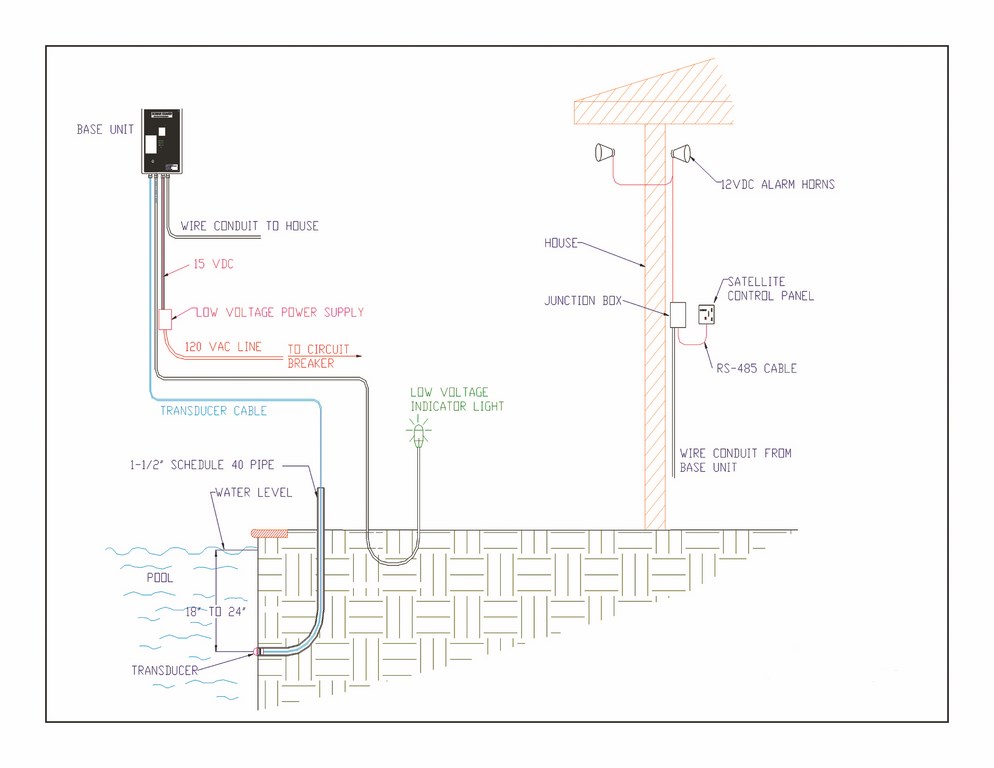Sound Solutions

 Developing a simple, reliable swimming pool alarm system offers a remarkable range of technical challenges, observes Robert Jechart of RJE Technologies – even when your point of departure is years of experience with ultra-sophisticated military and commercial sonar technology. Here, he discusses a four-year process in which his company has addressed its goal of making watershapes safe for families with small children.
Developing a simple, reliable swimming pool alarm system offers a remarkable range of technical challenges, observes Robert Jechart of RJE Technologies – even when your point of departure is years of experience with ultra-sophisticated military and commercial sonar technology. Here, he discusses a four-year process in which his company has addressed its goal of making watershapes safe for families with small children.
Complex problems very often require sophisticated solutions – and that’s certainly the case in developing a swimming pool alarm system that’s able to distinguish between common surface disturbances and children entering the water.
My personal experience in this field began when a good friend of mine, deep in the process of purchasing a backyard swimming pool several years ago, expressed his concern about the safety of his children and frustration about his conclusion at that time that there was no truly reliable pool alarm system.
He eventually decided to install a safety cover – but he was still worried about the periods of time when the cover would be open and suggested I consider applying sonar technology to the problem. Our firm, RJE International, was founded in 1991 and now supplies some of the most advanced equipment for underwater sonar applications for the military as well as the commercial aviation and diving industries.
Four years ago, we established a sister company, RJE Technologies, for the sole purpose of devising a system that would provide another layer of protection for swimming pool owners concerned about the safety of their children. Given our background in manufacturing systems that leave no room for failure, we were confident that we could develop a viable alarm system for residential swimming pools. What we found, however, was that this seemingly simple task was in fact extraordinarily difficult.
DISCOVERIES
We soon found that the main problem associated with common alarm technologies was their inability to distinguish between real and false alarms. That’s not surprising, considering the huge array of things and incidents that can disturb a body of water, and it made sense for product designers to err on the side of caution by ramping up system sensitivity.
Industry people we contacted confirmed that existing systems performed as designed – but that the levels of false alarming made their clients unhappy and, as a consequence, left these contractors less than excited about recommending alarm systems for their projects.
We knew from our experience with other applications that underwater sonar systems possess the ability to distinguish the physical characteristics of a range of objects, making it seem reasonable that our technology could be set up in such a way that it could tell the difference between a small child and, say, a basketball or a hail storm.
| A big part of our multi-year product-development program had to do with calibrating the detection system so that basketballs and other objects that hit or penetrated the water’s surface would not trigger false alarms. We’d set up temporary probes in test pools and repeatedly drop, throw or roll common backyard objects into the water, gradually narrowing the sonar net’s sensitivity to the point where it could reliably tell the difference between these impacts and those made by a full-scale model of a one-year-old child dropped into the water. |
Before we moved onto any technical specifics, we knew that any system we developed would be far more expensive than the comparatively low-cost alarm systems on the market at that time. It was also immediately evident that we needed to create a system that could readily accommodate the variety of conditions found in swimming pools, which in turn meant that extensive technical support and in-field service would be crucial in bringing the product to market.
Above all, we were committed to the idea that any product we brought forth would be developed with the same level of precision and rigorous testing that we had always employed in our work for the military and other high-tech industries.
In other words, we knew we were in for a long-term process of research and development – and that success would require patience. System design, product development, extensive testing and rounds of problem-solving were all pursued with the advice and support of watershapers – all in all, an arduous process that, from time to time, caused many of us to question the wisdom of traveling down this path.
The process was difficult because reliability is a huge challenge – beginning with the fact that, when it comes to the technology we were beginning to apply, every swimming pool is different.
They’re shaped differently with a range of sizes, depths and internal contours. They have an array of associated features, from attached spas and fountains to waterfalls, grottos and slides, all of which can add levels of sonic interference. There are climactic differences and variations in surface disturbances caused by wind and rain. And there are significant issues having to do with the human interface: Any effective system had to be easy to use, easy to live with and completely, effortlessly reliable through a period of several years.
DELVING DEEPER
As we moved forward, we discovered something important almost immediately: Although the sonar systems with which we were already familiar work very well in open water, the confines of a swimming pool create reflective surfaces and are subject to a great deal of sonar-detectable “noise” from the circulation system and moving waterfeatures – not to mention surrounding environmental noise and vibration from street traffic, airline over-flights and more.
As a result, we had to re-engineer some systems at a very early stage and have since patented some new technologies that effectively filter certain types of noise and isolate the “signature” that is created when a person enters the water.
|
Ripple Effects Sonar works on a principle best illustrated by taking a rock and dropping it into a quiet body of water: Emanating from the point where the rock breaks the surface are waves – in essence, sound waves that are created by the pebble’s or rock’s action in breaking the surface. By extension, sonar is the science of manipulating and reading sound waves to locate objects under water. It typically uses extremely low frequencies that are not heard by the human ear. Modern scanning sonar is an advanced version of this technology that uses an array of acoustic transducers (underwater antennae) to send and receive signals across a wide range of frequencies. This enables the system to “paint” an object in terms of size, shape, distance and motion. As such, it’s very similar to radar – but instead of using electromagnetic waves, the sonar system uses sound waves. To develop the system described in the accompanying article, we needed to devise an entirely new type of sonar system that uses transducers set in fixed locations within small bodies of water. To our knowledge, this has never been done before in a way that enabled a sonar system to discern something as specific as the physical signature of a small child. When we engaged ourselves in this process, we thought to borrow military technology and apply it in new ways. Ironically, this new sonar technology may well have applications beyond pool safety that reach back instead into our military and commercial systems. — R.J. |
Another limitation in many pool environments is that a number of “blind spots” are usually created by contours of the interior surface or by objects within the pool itself. This meant that we would have to apply sonar in a way that was completely new and different from the sorts of open-water applications with which we were familiar and comfortable.
To make a longer-than-hoped story short, it took us a lot more time than we thought it would to develop a system that accommodated all of the in-pool factors we’d observed. Initially, we thought we’d come to market in about two years. Instead, the process has taken twice that long – and instead of borrowing and reapplying technologies, we found that we were inventing whole new ones.
As we worked, we kept our eyes on a couple of core features that just had to be there. First, we decided early on that the system would have to be fully automated, with its own intelligence and its own database. Second, it had to encompass all of its key operations while allowing the homeowner to forget about it until he or she actually uses the pool. In other words, the only interaction the homeowner has with the system is to place it in a standby mode when the pool is in use.
Basically, the sonar system uses continuous-wave technology, which allows us to establish a standing wave pattern throughout the pool that serves as an underwater sonar net. The electronic system uses a complex set of algorithms that enable it to recognize various physical characteristics (size, shape, surface reflection) that, when analyzed together, create a reliable signature of a small child.
Our minimum physical threshold is based on an average one-year old child: Anyone that size or larger entering the water when the system is armed will trigger the alarm.
TESTING THE TECHNOLOGY
Because we were marching into new technological territory, much of our product development time had to do with testing, analysis, debugging and retesting.
In all, we ran some 6,000-plus tests in more than 30 different pools – an extremely painstaking process that yielded a variety of surprises mostly having to do with the way sound waves work within a swimming pool. In those three-plus years of testing, we tried every conceivable way of getting the system to register false alarms and then made adjustments to accommodate what we observed.
Along the way, we attended to a wide range of factors that affect sonar function and found that there were some things we simply could not do. Pools with extremely large waterfalls – such as those in which torrents of water flow over the opening of grottos – are not conducive to use of sonar technology because the flow creates a significant dead spot in that part of the pool.
| Testing with objects that floated (such as basketballs) was only part of the development process. We also used irregular-shaped objects such as plastic rocking horses – things that would actually penetrate the surface and definitely engage the sonar net the way a bobbing child would – with the aim of “teaching” the system to recognize the specific sort of splash signature a small child makes. In all, we conducted more than 6,000 tests in pools of various configurations and applied everything we learned in refining the system. |
We found that some types of pool cleaners present significant problems as well. To work with these sorts of features and devices, we’ve developed a simple way to program our system so that it switches to a standby mode when cleaners or waterfeatures are functioning. This happens automatically, so that the homeowner doesn’t need to think about it.
In that sense, we learned our limits and know that the system is not for every application. We also came to recognize the limitation of any system that only operates once someone is in the pool and came to see ours as a last layer of protection among others we recommend for homes where children live.
Key among those recommended systems are automatic pool covers. This is so important that we’ve set up our system so that it can be set up to work only when the cover is open.
Finally, a great deal of thought and testing went into the sound of the alarm itself. Because modern homes are filled with so many beeps, buzzes and twitters from all manner of electronic devices, we were challenged to come up with something that was distinctive enough to be recognizable among all the other noisemakers around us.
Our solution was to use a sonar sound effect, the sort of ping one associates with sonar as it is used on submarines – and a unique noise that everyone we’ve worked with has said does indeed command immediate attention.
NECESSARY SUPPORT
In terms of physical installation, the process is fairly simple. The system, which we’re marketing as SonarGuard, consists of transducers (underwater sensors) that are mounted on the interior surface of the pool; a central processing unit mounted on or near the equipment pad; and a wall-mounted user interface that is typically mounted inside the house adjacent to the pool’s remote-control system.
The transducers are mounted, typically at 20 to 22 inches below the waterline, in small 1-1/2-inch sleeves that are roughed into the pool during construction and attached to a conduit that runs back to the central processing unit. It’s very important that the transducers be mounted perfectly flush with the pool-wall surface and in accordance with a diagram provided by our support staff to ensure proper coverage.
| Once the pool’s configurations are set, we can decide how many probes will be required to cover the pool without leaving any areas unprotected by the sonar net — and then specify precisely where they are to be installed. Beyond that, the system is pretty straightforward and goes up much like other remote-control devices – except that our technical staff comes on site to make certain everything is operating to specifications. |
To make the system work, in fact, we need to see a plan before the pool is shot with gunite. Designers or builders send us plans, and we map out the transducer locations. Each pool must have a minimum of two transducers, but larger and more elaborate pools can require many more.
We’ve also have developed techniques for installing the system in existing pools, the largest challenge being to conceal the wire in the deck’s expansion or grout joints. In these cases, the transducers are surface mounted, and the wiring is run through a flat, surface-mounted conduit that comes in various colors to match existing pool finishes.
Whether the pool is new or old, we’re prepared to provided whatever support is needed to address any problems with the system immediately. To ensure that level of responsiveness, we’ve taken our approach to market very slowly and carefully. Only recently have we become ready to offer the system on a widespread basis.
In all we do, our aim is to address a difficult safety issue with the most advanced technology available. We know from our experience in other industries what it’s like to offer products that must always operate in life-or-death situations, and we know what it means to create products in an environment where a system failure can be catastrophic.
It is our hope that this experience can benefit those who want to enjoy the basic joys of pool ownership with increased peace of mind.
Robert Jechart is president and CEO of RJE Technologies, Inc., an Irvine, Calif.-based manufacturer of a sonar-based alarm system for swimming pools. He founded the firm in 1999 as a sister company to RJE International, a world-leading supplier of underwater sonar technology for military and commercial applications that Jechart founded in 1991. His career in high technology began when he worked with his father, Ernst Jechart, the world-renowned inventor of the modern atomic clock now on display at the Smithsonian Institution in Washington, D.C. In 1980, he founded (and later sold) an electronics-manufacturing firm dedicated to underwater wireless communication. Jechart is past president and a founding member of the Orange County (Calif.) Chapter of the Young Entrepreneur’s Organization among many other community and education-based activities.













